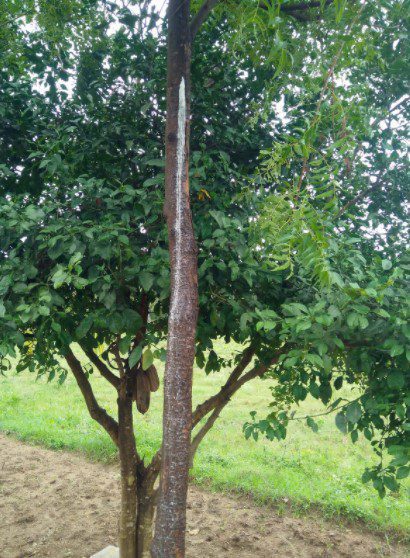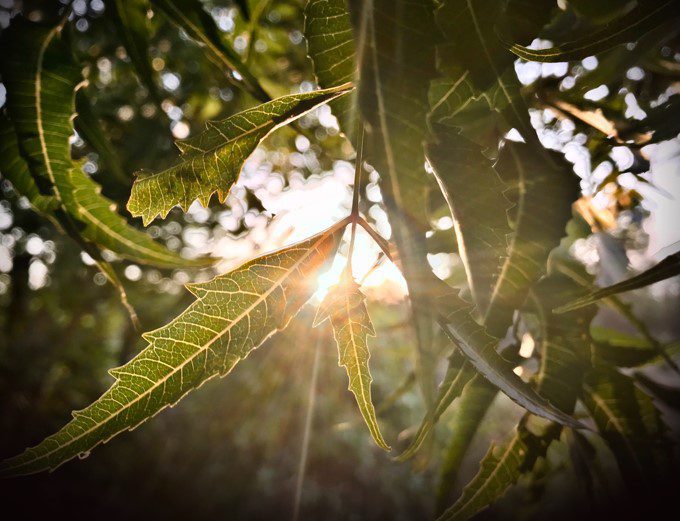Neem Tree
Amazing Powers Of Neem Tree
Scientists in Canada and around the world are intrigued by the unusual powers of the neem tree, a tree that commonly grows in India, Burma, and across the Third World.
Products derived from the neem, a member of the mahogany family, can be used as pesticides, toothpaste, soap, and possibly as a spermicide.
According to a Washington-based National Research Council report, the neem “may eventually benefit every person on the planet.
“Probably no other (tree) yields as many strange and varied products or has as many exploitable by-products,” says the NRC, a private, non-profit society that advises the U.S. government.
But Canadian scientists say the neem‘s future applications are clouded by uncertainty.
“There’s a lot involved,” says Dr. John Arnason, a botanical pesticides expert from the University of Ottawa.
“If you think it’s just a simple matter of bringing the seeds over from India, then dream on.”
Arnason would like to promote the use of neem as an alternative to chemical pesticides.
Neem Tree Use As Pesticide
The American panel found the mixture to be effective against 45 insects considered dangerous to crops in the U.S. and Canada.
University of Ottawa student Diane Gagnon has just completed her master’s thesis on the neem‘s effectiveness in battling the European corn borer, a constant worry for sweet-corn farmers in Eastern Ontario.
She tested a neem-derived pesticide for three summers on a half-acre of sweet corn growing at the Central Experimental Farm in Ottawa.
“We found it was one of the most effective compounds,” says Gagnon, 32, a Hull, Que., resident.
She points out, however, that there are problems with ensuring a “stable formulation.”
For one thing, ultra-violet light tends to degrade the neem pesticide, making it lose its pest-control properties.
Neem Tree Effects on Humans
More importantly, perhaps, the effect of neem on humans has not been fully tested.
“Although neem has shown every indication of being safe to mammals in normal use as a pesticide, the possibility of future hazards should not be dismissed,” the American research council’s report says.
For centuries, neem‘s powers have been well known to rural Indians.
According to the American report, millions use neem twigs to clean their teeth, drink neem-tea as a tonic, smear neem-leaf juice on skin disorders and place neem leaves in their beds and cupboards to fend off bugs.
“The tree has relieved so many different pains, fevers, infections, and other complaints,” the report says, “that it has been called the “village pharmacy.’ ”
Extracts from the neem, a member of the mahogany family, contain four major and as many as 20 minor active compounds.
The result? Products derived from neem can be used as a pesticide, toothpaste, soap, and possibly a spermicide.
For centuries, neem’s powers have been well known to rural Indians. According to the American report, millions use neem twigs to clean their teeth, drink neem-tea as a tonic, smear neem-leaf juice on skin disorders and place neem leaves in their beds and cupboards to fend off bugs.
”The tree has relieved so many different pains, fevers, infections, and other complaints that it has been called the ‘village pharmacy.”’
The authors of the upbeat American report make neem sound like a cure for anything but the blues.
For instance:
”Because neem is a tree, its large-scale production promises to help alleviate several global environmental problems: deforestation, desertification, soil erosion, and perhaps even (if planted on a truly vast scale) global warming.”
There is already a neem-based product, Margosan-O, on the market in at least 21 U.S. states. It’s effective on such insects as aphids and whiteflies.
Neem Tree Information
The neem grows to about 30 meters in height, produces honey-scented white flowers and olive-sized fruit. It has thick foliage, which is retained year-round, making it a prized shade tree.
The tree is common in the Indian subcontinent and has been established in some 30 countries around the southern fringe of the Sahara. In some regions, it is a prime source of firewood.
The neem cannot withstand freezing and, in North America, exists only in small pockets in the southern United States.

”I like to compare the neem to aspirin,” says Dr. Cherla Sastry, a forestry chemist, and program officer with Canada’s International Development Research Centre.
”It can be a wonderful thing for any and everything.”
IDRC is funding a $30,000-project in India on the possible uses of neem, an effort being supported by Canadian expertise.
Most of the neem’s pesticide powers come from an active ingredient called azadirachtin, which disrupts the insect’s growth and reproduction.
Scientists and farmers make insecticide by taking neem seeds, grinding them, and concocting an alcohol extract.
The American panel found the mixture effective against 45 species of insects considered dangerous to crops in the U.S. (Many of these pests are also found in Canada.)
Several Canadian researchers, including a handful in Ottawa, have studied the powers of the neem. They’re more restrained than the Americans in their assessment of the tree’s potential.
”There’s a lot involved,” says Dr. John Arnason, an expert on botanical pesticides from the University of Ottawa.
”If you think it’s just a simple matter of bringing the seeds over from India, then dream on.”
Arnason would like to promote the use of neem as an alternative to chemical pesticides.
”It’s very effective when handled properly… but it’s not a panacea.”
University of Ottawa student Diane Gagnon has just completed her master’s thesis on the neem’s effectiveness in battling the European corn borer, a constant worry for sweet-corn farmers in Eastern Ontario.
She tested a neem-derived pesticide for three summers on a half-acre of sweet corn growing at the Central Experimental Farm.
Neem Tree Oil Use As An Intravaginal Spermicide
”Whether neem oil is safe for possible use as an intravaginal spermicide is also unclear… Its use as a spermatocide… is so uncertain that it will probably take decades of research study to develop even if no safety hazards are found along the way.”
Gagnon, meanwhile, sees a neem product forming only one part of a farmer’s pesticide program — a companion to artificial chemicals.
She also offers a reminder that the natural way isn’t always better. ”People think that because a product is natural, then it’s not toxic. But there are all kinds of plants that contain toxic compounds.”
Conclusion?
”We found it was one of the most effective compounds,” says Gagnon, 32, a Hull resident.
She points out, however, that there are problems with ensuring a ”stable formulation.”
For one thing, ultra-violet light tends to degrade the neem pesticide, making it lose its pest-control properties.
Regulating pesticides in North America is a rigorous exercise and requires, among other things, a precise description of what a product contains.
Scientists have found that the composition of neem varies from batch to batch and from country to country. They’ve also found that the active ingredients in the kernels, over time, lose their potency.
More importantly, perhaps, the effect of neem on humans has not been fully tested.
”Although neem has shown every indication of being safe to mammals in normal use as a pesticide, the possibility of future hazards should not be dismissed,” the American research council’s report says.
The IDRC’s Sastry says it’s easy to see why the scientific community is so hopeful about the neem: the enormous potential to help people in the Third World.
Because the tree is plentiful, farmers without chemical fertilizers would benefit from a cheap, simple way to extract a neem-derived pesticide.
The tree also seems to hold awesome potential in the area of birth control.
The American agency reports that a test involving the wives of 20 Indian army personnel indicated neem’s effectiveness as a spermicide.
It adds these words of caution, however.


























